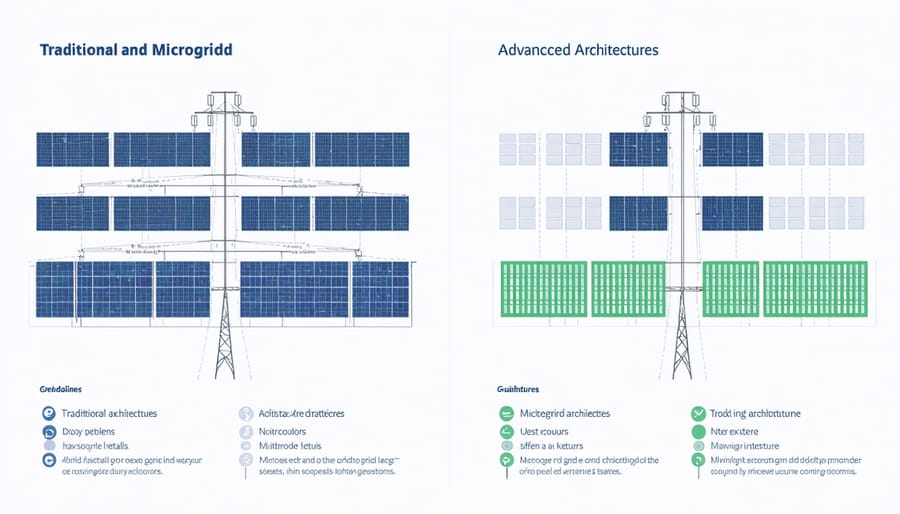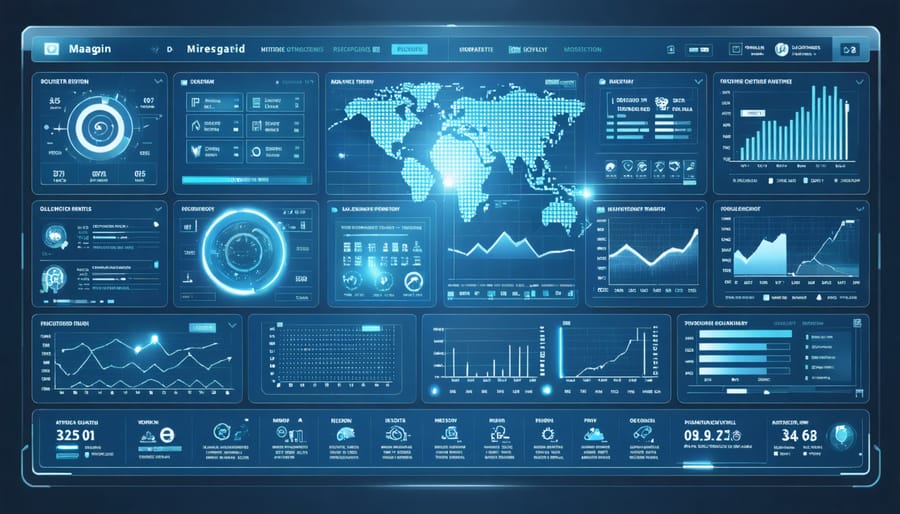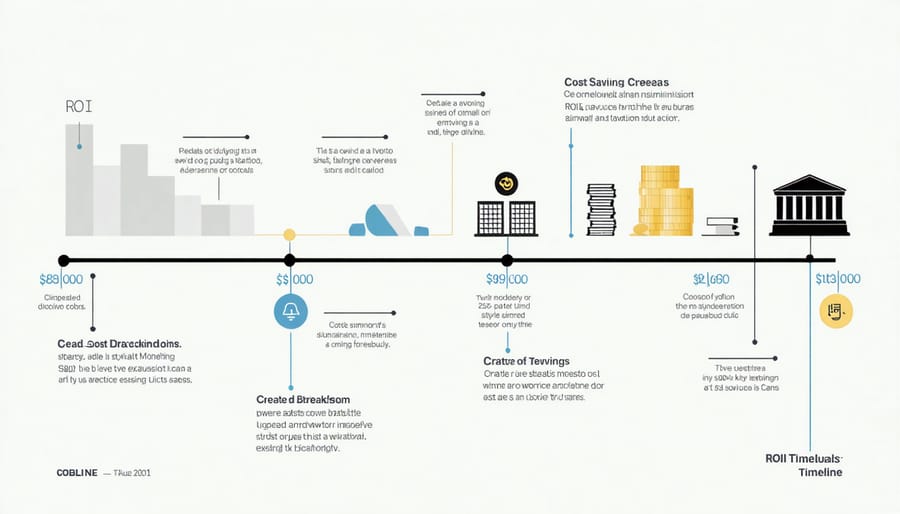Advanced microgrid solutions represent a transformative leap in energy management, combining intelligent power distribution with renewable integration to create resilient, self-sustaining energy ecosystems. These sophisticated systems enable businesses and communities to optimize their energy consumption, reduce operational costs, and maintain critical operations during grid disruptions.
At the forefront of modern energy infrastructure, advanced microgrids leverage AI-driven controls, energy storage systems, and distributed energy resources to deliver unprecedented reliability and efficiency. They seamlessly integrate solar arrays, battery storage, and traditional power sources while providing real-time load balancing and automated demand response capabilities.
The evolution from traditional grid systems to advanced microgrids marks a decisive shift toward energy independence and sustainability. Organizations implementing these solutions report average energy cost reductions of 25-30% while significantly improving their carbon footprint. For facility managers and business leaders, advanced microgrids offer a strategic advantage in an increasingly unpredictable energy landscape, providing both operational resilience and environmental stewardship.
As global energy demands evolve and grid vulnerabilities become more apparent, advanced microgrid solutions stand as a proven framework for future-proofing energy infrastructure while delivering measurable returns on investment. These systems represent not just an energy solution, but a comprehensive strategy for sustainable business operations.
The Evolution of Solar Microgrids
Traditional vs. Advanced Microgrid Architecture
Traditional microgrids typically operate as isolated power systems with basic control mechanisms, relying on conventional generators and simple load management. These systems, while functional, often lack the sophistication needed for optimal energy distribution and cost efficiency. In contrast, advanced microgrid architectures incorporate sophisticated smart grid integration capabilities, artificial intelligence, and dynamic load balancing.
Modern systems excel in their ability to seamlessly integrate multiple renewable energy sources, energy storage solutions, and intelligent demand response mechanisms. They feature advanced power electronics, real-time monitoring systems, and automated decision-making protocols that optimize energy flow based on usage patterns and market conditions.
The key differentiator lies in their adaptive nature – advanced microgrids can automatically switch between grid-connected and island modes, prioritize renewable energy usage, and implement sophisticated peak-shaving strategies. This results in significantly improved reliability, reduced operational costs, and enhanced energy security compared to traditional configurations. Furthermore, advanced architectures support bidirectional power flow, enabling facilities to participate in energy markets and generate additional revenue streams through grid services.

Key Components of Advanced Solar Microgrids
Advanced solar microgrids rely on several critical components working in harmony to ensure reliable, efficient operation. At the core is the solar PV array system, which serves as the primary power generation source, typically complemented by high-capacity energy storage systems using lithium-ion or advanced battery technologies.
The intelligent control system acts as the brain of the microgrid, utilizing sophisticated algorithms to optimize power flow, manage load distribution, and seamlessly switch between grid-connected and island modes. Power conversion equipment, including inverters and power conditioning systems, ensures smooth integration between AC and DC power sources while maintaining power quality.
Advanced metering infrastructure (AMI) provides real-time monitoring and data analytics capabilities, enabling predictive maintenance and performance optimization. The distribution network incorporates smart switches and protective devices that enhance system reliability and safety.
Load management systems prioritize critical operations during peak demands or emergencies, while the grid-tie interface enables communication with the main utility grid when connected. These components are integrated through a robust communication network that ensures coordinated operation and remote monitoring capabilities, essential for modern microgrid functionality.
Smart Integration Technologies
AI and Machine Learning Applications
Artificial intelligence and machine learning technologies are revolutionizing microgrid management, delivering unprecedented levels of efficiency and reliability. Through sophisticated algorithms and real-time data analysis, AI systems optimize power distribution, balance loads, and maximize renewable energy utilization across the microgrid network.
AI-powered predictive maintenance capabilities significantly reduce downtime and maintenance costs by identifying potential issues before they cause system failures. These smart systems analyze patterns in energy generation, consumption, and storage to make intelligent decisions about resource allocation and grid stability.
Machine learning algorithms continuously adapt to changing conditions, including weather patterns, energy demand fluctuations, and market pricing dynamics. This enables microgrids to automatically optimize their operation for maximum cost-effectiveness while maintaining reliable power supply. The technology can forecast energy needs with remarkable accuracy, allowing for proactive adjustments in energy storage and distribution strategies.
Advanced AI applications also facilitate seamless integration with utility grids, optimizing when to consume, store, or sell excess power back to the grid. This intelligence creates new revenue opportunities while ensuring energy security for facilities. For business owners and facility managers, these AI-driven solutions translate into reduced operational costs, improved energy reliability, and enhanced return on investment in microgrid infrastructure.

Advanced Energy Storage Solutions
Modern microgrids rely heavily on advanced energy storage solutions to maintain reliability and maximize renewable energy utilization. Battery systems have evolved significantly, with lithium-ion technology leading the way due to its high energy density, rapid response capabilities, and declining costs.
These storage systems now incorporate sophisticated battery management systems (BMS) that optimize charging cycles, extend battery life, and ensure safe operation. Advanced thermal management and smart inverter technology enable seamless integration with existing power infrastructure while maintaining grid stability.
Flow batteries are emerging as a promising alternative for longer-duration storage needs, offering extended operational lifespans and the ability to decouple power from energy capacity. Additionally, hybrid storage systems combining different technologies – such as lithium-ion batteries for short-term response and flow batteries for longer-duration backup – are becoming increasingly common in commercial installations.
Integration of artificial intelligence and machine learning algorithms enables predictive maintenance and optimal dispatch strategies, maximizing the economic value of stored energy. These systems can anticipate peak demand periods, store excess renewable generation, and provide ancillary services to the grid, creating multiple revenue streams for facility operators.
Real-world implementations demonstrate the effectiveness of these solutions, with many commercial facilities reporting 30-40% reductions in peak demand charges and improved resilience against grid outages.
Real-World Implementation
Commercial Success Stories
Advanced microgrid solutions have demonstrated remarkable success across various commercial sectors, with several organizations leading the way in implementation and achieving significant returns on investment. The Brooklyn Microgrid project stands as a pioneering example, where a community-based energy marketplace has enabled local businesses to reduce energy costs by 15-20% while ensuring reliable power supply during grid outages.
Marcus Garvey Village in New York showcases how commercial residential properties can benefit from microgrid technology. The 625-unit apartment complex integrated a solar-plus-storage system that generates $170,000 in annual utility bill savings while providing critical backup power during emergencies.
In the industrial sector, the Stone Edge Farm Estate Vineyards & Winery in California implemented a sophisticated microgrid that combines solar power, hydrogen fuel cells, and advanced storage systems. This installation not only achieved complete energy independence but also maintained continuous operations during regional power shutoffs, preventing significant crop losses.
The Montgomery County microgrid in Maryland demonstrates public sector success, powering critical facilities including public safety headquarters and correctional facilities. The system generates $4 million in energy savings over its lifetime while ensuring operational continuity during grid disruptions.
Blue Lake Rancheria’s microgrid in California exemplifies tribal community success, reducing energy costs by 30% annually while creating local jobs and providing emergency services to the surrounding community. During regional power shutoffs, the facility served as an emergency response center, supporting over 10,000 community members.
These implementations showcase how advanced microgrid solutions deliver both financial returns and operational resilience, making them increasingly attractive for commercial applications across diverse sectors.
Government and Institution Applications
Government institutions worldwide are increasingly adopting advanced microgrid solutions to enhance energy security, reduce operational costs, and meet sustainability goals. Military installations have been at the forefront of this transition, implementing sophisticated microgrids that ensure continuous power supply for critical operations while reducing dependence on traditional grid infrastructure.
Notable examples include the Marine Corps Air Station Miramar in San Diego, which operates a comprehensive microgrid system incorporating solar power, natural gas, and energy storage. This installation can operate independently during grid outages and has demonstrated significant cost savings while maintaining mission-critical operations.
Educational institutions have also embraced microgrid technology, with universities leading the way in both implementation and research. The University of California San Diego’s microgrid manages approximately 85% of the campus’s electricity needs, serving as a model for large-scale institutional applications.
Government facilities such as hospitals, emergency response centers, and municipal buildings are implementing microgrids to ensure uninterrupted service during natural disasters or grid failures. These systems have proven particularly valuable in regions prone to extreme weather events or grid instability.
The success of these implementations has led to increased government funding and support for microgrid projects. Many states now offer grants and incentives for public institutions to develop microgrid capabilities, recognizing their role in grid resilience and emergency preparedness.
Performance data from these installations consistently shows reduced energy costs, improved reliability, and decreased carbon emissions. These outcomes have encouraged other government entities to explore similar solutions, creating a growing ecosystem of public sector microgrid applications.
Economic Benefits and ROI

Cost Savings Analysis
Advanced microgrid solutions offer substantial cost savings through multiple revenue streams and efficiency improvements. Studies show that businesses implementing these systems typically achieve a commercial energy ROI within 5-7 years, with some facilities reporting faster payback periods.
The primary cost reductions come from decreased grid dependency, with organizations reporting 30-45% lower utility bills on average. Peak shaving capabilities alone can reduce demand charges by 20-30%, while intelligent load management systems optimize energy consumption patterns for maximum savings.
Real-world implementations demonstrate impressive financial outcomes. A manufacturing facility in Melbourne achieved annual savings of $180,000 through strategic microgrid deployment, while a Sydney-based data center reduced operational costs by 35% in the first year.
Additional savings emerge from:
– Reduced transmission and distribution losses
– Lower maintenance costs through predictive analytics
– Revenue generation through demand response programs
– Protection against future electricity price increases
– Extended equipment lifetime through optimized operation
When factoring in government incentives and renewable energy certificates, the total cost benefit can exceed $500,000 over a ten-year period for medium-sized facilities. Organizations also benefit from enhanced energy security, minimizing costly downtime and production losses during grid outages.
Long-term Financial Benefits
Advanced microgrid solutions provide substantial long-term financial benefits that extend well beyond initial energy cost savings. Over time, these systems create multiple revenue streams and cost reduction opportunities that significantly improve the return on investment for organizations.
The most immediate financial advantage comes from reduced utility expenses, with organizations typically seeing 20-30% reductions in their energy costs within the first year. This saving compounds annually, particularly as traditional utility rates continue to rise. Additionally, microgrids enable participation in demand response programs, allowing facilities to generate revenue by adjusting their power consumption during peak periods.
Asset optimization and predictive maintenance capabilities inherent in advanced microgrid systems help prevent costly equipment failures and extend the lifespan of energy infrastructure. Organizations can expect a 15-25% reduction in maintenance costs through proactive monitoring and automated system management.
The integration of renewable energy sources within microgrids also provides access to various tax incentives, grants, and renewable energy credits. These financial instruments can significantly offset initial installation costs and provide ongoing revenue streams. Furthermore, enhanced power reliability reduces costly downtime, with studies showing that businesses can avoid losses of up to $150,000 per hour during critical power outages.
As carbon pricing and environmental regulations become more prevalent, microgrid-enabled facilities are better positioned to avoid future compliance costs and potential penalties, while maintaining competitive advantages in increasingly sustainability-conscious markets.
Advanced microgrid solutions represent a transformative approach to energy management, offering organizations unprecedented control over their power infrastructure while advancing sustainability goals. As demonstrated throughout this article, these systems combine sophisticated energy management technology with renewable sources to create resilient, efficient, and cost-effective power networks.
The future of microgrids looks increasingly promising, with technological advances driving down costs and improving system capabilities. Market projections indicate substantial growth in microgrid adoption across various sectors, from commercial facilities to industrial complexes and municipal infrastructure. This expansion is fueled by increasing grid reliability concerns, renewable energy integration requirements, and the growing need for energy independence.
Key developments on the horizon include enhanced AI-driven control systems, improved energy storage solutions, and more seamless integration with existing grid infrastructure. These innovations will further optimize energy distribution, reduce operational costs, and maximize renewable energy utilization.
For organizations considering microgrid implementation, the time to act is now. Early adopters are already realizing significant benefits, including reduced energy costs, improved reliability, and enhanced environmental performance. As regulations evolve and grid challenges persist, advanced microgrid solutions will become increasingly vital for organizations seeking to secure their energy future while meeting sustainability objectives.
Success in this transition requires careful planning, proper system design, and partnership with experienced providers who understand both technical requirements and business objectives. The investment in advanced microgrid solutions today will position organizations for long-term success in an evolving energy landscape.

